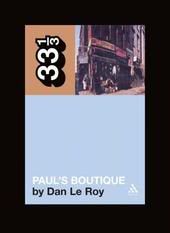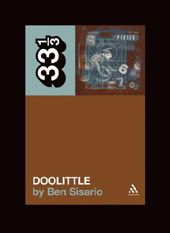MUSIC: The Pixies and Beastie Boys
get the 33 1/3 treatment
I admit, my music tastes weren't real cool in 1989. It was the start of senior year in high school, and "edgy" for me was Depeche Mode. One of my big thrills my senior year was going to a Billy Joel concert. I bought a T-shirt. Heck, I still have a soft spot for "We Didn't Start The Fire" today, but these days my music radar is a bit broader than it used to be. In 1989, I had no clue that I missed out on two of the seminal albums of my time – The Pixies' roaring manifesto Doolittle, and the Beastie Boys' psychedelic mix tape Paul's Boutique.
I actually got The Pixies' Doolittle by mistake in 1990 as part of a record club I was in … didn't know quite what to make of this clattering, screeching CD, and it took me a few years to get into it. Paul's Boutique I didn't discover until the mid-1990s, when the Beastie Boys finally lost the frat-boy image after hip-hop blasts like Check Your Head and Ill Communication. Now, both of these two very different albums are high up in my list of Desert Island CDs.
So hats off to Continuum Books' fab 33 1/3 music-criticism series, which examines the Pixies' and the Beasties' 1989 slabs of sound in two new books. Each slim 100-page-or-so book in the series dissects a particular CD, like liner notes on steroids. The Pixies book by Ben Sisario and the Beastie Boys book by Dan LeRoy are both swingin' samples of the series' rock-geek eye for minutiae and big-picture grasp of the trends and visions that go into the albums we love.

LeRoy's Paul's Boutique volume will hit the spot for Beasties fans, many of whom still consider the Beastie Boys' madcap second CD their best. LeRoy establishes the revolutionary sophomore record Boutique was. The Beasties made their name with loud, thrashing proto rap-rock like "Fight For Your Right To Party," but the leering goons in the early videos weren't really who they wanted to be. Paul's Boutique was the response to those who thought they'd pegged the Beasties as one-hit wonders – a still-remarkable collage of samples, slick multi-referential rhymes and an ever-shifting soundscape. A tune like "Sound of Science," built almost entirely of riffs by none other than the Beatles, still kicks it today.
LeRoy painstakingly reconstructs how Boutique came to be. He builds a pretty strong case that Boutique can be considered a strong collaboration between the Beasties, the Dust Brothers and reclusive producer Matt Dike, who had assembled the sample-filled bones of some of the songs on his own even before the Beasties came along. That helps explain why Paul's Boutique doesn't sound quite like anything else the Beasties ever did. It also pretty much bombed in 1989, coming nowhere near the success of the Beasties' License To Ill and only gaining its current shining reputation over time. LeRoy provides a guide to some of the arcane samples peppered throughout the album, noting it's "impossible … to comprehend in its sprawling totality." Paul's Boutique is a gorgeously dense piece of work, and LeRoy explains how post-1989 changes in sampling laws mean nothing like it will ever quite happen again. Given the confines of a 128-page book, LeRoy can't be utterly encyclopedic about the disc — and sometimes a broader picture of the Beasties' influences and inspirations is lacking – but he is pretty darned solid at showing the voices and ideas that went into it.

The Pixies, unlike the Beasties, didn't become truly famous until they'd broken up. Their "prickly kind of pop," Sisario notes, wasn't ever Top 10 material, but influenced many (notably Kurt Cobain, who idolized the band). Their second album proper, Doolittle, is a jagged, glistening knife of a listen, strangely sunny despite the loud-to-soft howls of frontman Charles Thompson (aka Black Francis) and titles like "Debaser," "Gouge Away," "There Goes My Gun" and "Mr. Grieves." Seventeen years on, Doolittle – originally titled Whore – still sounds fresh and fiery. Sisario shows how the Pixies' unique alchemy rocketed them to "next big thing" status, and how they soon imploded in the usual ego and fame struggles.
Sisario really manages to capture some of Thompson's elusive personality as he road-trips with him around his Eugene, Ore., home. He illuminates some of the thinking that went into the songs that became alt-rock anthems, and he goes after Doolittle's twisted lyrics with a scholar's eye. It might spoil the mystery of the songs a bit for some, but I found it fascinating to learn that, say, "Crackity Jones" is about Thompson's demented former roommate. Few secrets of Doolittle remain untold under Sisario's probing. Sisario heavily examines the influence of Surrealism on the Pixies' voice – Thompson ate up filmmakers like Buñuel and David Lynch, and his frenzied lyrics captured a kind of senseless joy and pain. Or, as Thompson himself puts it, the appeal of the Pixies lay in their "sex and death vibrations." Sisario's sharp analysis and exploration of Doolittle makes this 33 1/3 tome a must for Pixie-heads.
Both books suffer a tiny bit by not having the full bands' cooperation – the Pixies' Kim Deal refused to talk to Sisario, and only Mike D of the three Beasties spoke on the record to LeRoy. Yet that doesn't really matter too much. These 33 1/3 books aren't meant to be an all-inclusive band biography. Both authors bring to their task an easygoing yet authoritative voice. Reading these books, it's like it's 1989 all over again for me, and I can pretend I'm finally kinda sorta hip.

No comments:
Post a Comment